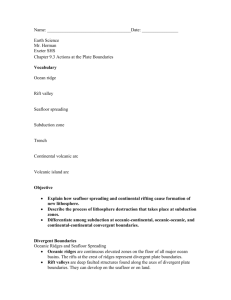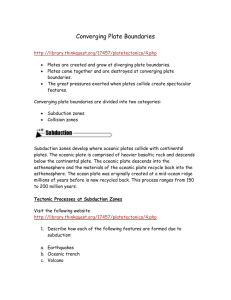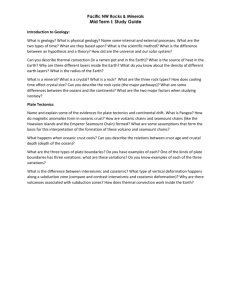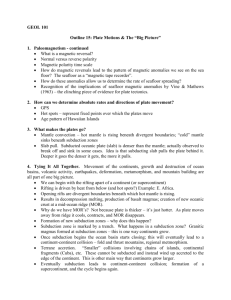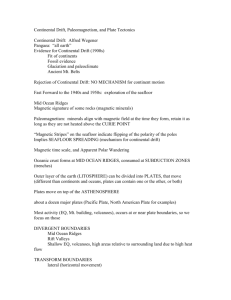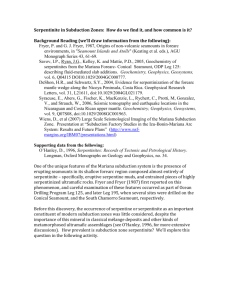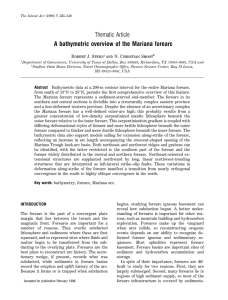Flexural_rigidity_minilession.v5
advertisement
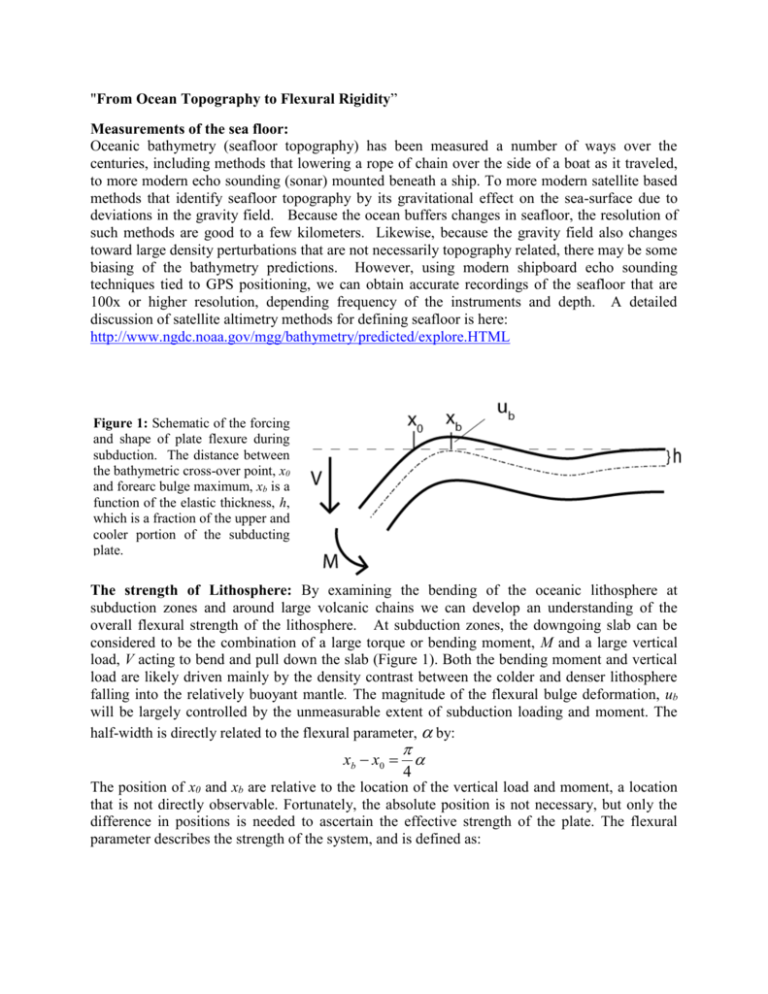
"From Ocean Topography to Flexural Rigidity” Measurements of the sea floor: Oceanic bathymetry (seafloor topography) has been measured a number of ways over the centuries, including methods that lowering a rope of chain over the side of a boat as it traveled, to more modern echo sounding (sonar) mounted beneath a ship. To more modern satellite based methods that identify seafloor topography by its gravitational effect on the sea-surface due to deviations in the gravity field. Because the ocean buffers changes in seafloor, the resolution of such methods are good to a few kilometers. Likewise, because the gravity field also changes toward large density perturbations that are not necessarily topography related, there may be some biasing of the bathymetry predictions. However, using modern shipboard echo sounding techniques tied to GPS positioning, we can obtain accurate recordings of the seafloor that are 100x or higher resolution, depending frequency of the instruments and depth. A detailed discussion of satellite altimetry methods for defining seafloor is here: http://www.ngdc.noaa.gov/mgg/bathymetry/predicted/explore.HTML Figure 1: Schematic of the forcing and shape of plate flexure during subduction. The distance between the bathymetric cross-over point, x0 and forearc bulge maximum, xb is a function of the elastic thickness, h, which is a fraction of the upper and cooler portion of the subducting plate. The strength of Lithosphere: By examining the bending of the oceanic lithosphere at subduction around large volcanic chains we can develop an understanding of the Though we zones cannotand directly overall flexural strength of the lithosphere. At subduction zones, the downgoing slab can be measure the magnitudes of considered theuse combination of a large torque or bending moment, M and a large vertical these loads,towebecan the load, V acting to bend and pull down the slab (Figure 1). Both the bending moment and vertical shape of the predicted plate to load are likely driven mainly by the density contrast between the colder and denser lithosphere identify the structure. We find falling the relatively that theinto horizontal distancebuoyant mantle. The magnitude of the flexural bulge deformation, ub will be largely controlled between the location of theby the unmeasurable extent of subduction loading and moment. The half-width directly related to the flexural parameter, by: maximum is forearc bulge, x0 and the seafloor zero point, x0 is xb x0 called the half-width of flexure 4 The and x are relative to the location of the vertical load and moment, a location and position can give of us xgreat insight 0 b that is not directly observable. Fortunately, the absolute position is not necessary, but only the difference in positions is needed to ascertain the effective strength of the plate. The flexural of the system, and is defined as: parameter describes the strength Figure 2: When making selections for x0 xb, and the average depth, zm, try and imagine a very smooth line (illustrated in red) that averages out all smaller signals. This profile is from the eastern Aleutians. 1/ 4 4D ( m w )g and is only affected by the density contrast between the mantle and water, m – w , gravity, g, and the flexural rigidity, D (explained below). Because the density contrast and gravity can be considered constant, D remains the only parameter that effects the half-width. D is defined as: D Eh 3 12(1 2 ) and varies most rapidly as the plate’s effective elastic thickness, h increases since D grows as h3. The remaining parameters are the material properties of the plate, where E is the Young’s Modulus and is the Poisson’s Ratio, and are near 75 GPa and 0.25 for oceanic lithosphere, respectively. As oceanic plates age and cool while they are in contact with the seafloor, they become thicker. The rate of plate thickening is theoretically described as occurring with the square root of age, tage. Since the elastic thickness, h is similarly controlled by cooling, and thus will follow a similar relationship, hence: h t age Experiment: We have learned that the plate thickness, and hence the effective elastic thickness, h should be controlled by age, and that the half-width of the forearc bulge, xb - x0 should be controlled by this thickness and a number of parameters that are near constant. Thus, we should test to see if we can observe the relationship between plate-age, forearc half width, and hence effective plate thickness. To do so, we will use the GeoMapApp (www.geomapapp.org) tool to identify the age and forearc half-width of a number of subduction zone environments. First by following the example off Nicaragua, and then by choosing three more subduction zones with visible forearc bulges and making similar measurements. Figure 3: Mercator projection of ocean floor off the Pacific Coast of Nicaragua. The sea floor in this region has a number of seamounts, and includes a dominant forearc bulge. For Cocos Plate subduction off of Nicaragua a. Determine the half-width and flexural rigidity. b. Open the GeoMapApp/Virtual Ocean toolset and choose profile. the Mercator c. Select the zoom button (hourglass with + sign) and click on the region offshore Nicaragua until the region is appropriately zoomed (between about 7° and 13° North and 90° and 85° West). d. Take a profile perpendicular to the strike of the trench of at least 300 km, with the NE end-point across the deepest point of the trench. To do this click on the profile box (6th box from right; ) and click at the beginning and ending points for the profile. Be careful to avoid seamounts!! See Figure 3. e. Now slide your cursor along the profile and use the information about oceanic topography at that point to answer the following questions. i. What is the depth of the trench (can be read off the profile)? ii. What is the mean depth of the seafloor away from the trench? iii. What is the shallowest point of the flexural bulge (avoiding seamounts), and how far is this from the trench? iv. Where is the bathymetric cross-over point, x0? v. What is the forearc half width xb-x0? vi. Given the above equations and your own assumptions about mantle and water density, what is the flexural rigidity, and effective elastic thickness? f. If you are interested, you can save the profile data to your computer. Within profile box, click save in the upper left-hand corner, and be sure to select ASCII table and save it as a text file, giving it a useful name (e.g., ‘NicaraugaProfile.txt’). This file can now be opened in almost any program that can read text files. 2.) Determine Plate Age: a. Note the approximate location of the forearc bulge (87°41’ W, 10°33’ N). b. Now. from the menu, choose, Basemaps -> Global Grids -> Seafloor Bedrock Age. What is the age the plate at the forearc bulge? 3.) Analyze other regions: (give specific regions that will get the results that you expect) a. Travel around the virtual globe and perform another three calculations of forearc halfwidths, for plates at their bulge. i. In making these measurements, be sure to get a variety of ages for oceanic plates. ii. You can use that mask function to identify regions that have higher resolution shiptrack data ( ), however it may be necessary to analyze mostly regions without such high-resolution data. iii. Not all trenches have well-established bulges, thus it is probably best to hunt around until you find ones that do. b. Record the half-width and age, and determine the effective elastic thickness for each. 4.) Comparison: a. On two graphs, plot each the effective thickness, h and half-width, xb-x0, as a function of age, tage. b. Do these results appear to increase with age? c. Do they increase at the rate expected? 5.) Discussion: If the results do not follow the expected trend, what reasoning can you give to explain this? a. Do you think these are primarily from measurement errors? If so, what are the sources of the measurement errors? Are they from the user, or from the data collection methods? b. Are there reasons that the plate itself may deviate significantly from the expected elastic thickness? If so, what are they? c. Did you find regions with no visible bulge? If so, what does this say about the overall elastic strength of the oceanic plate in those regions.
